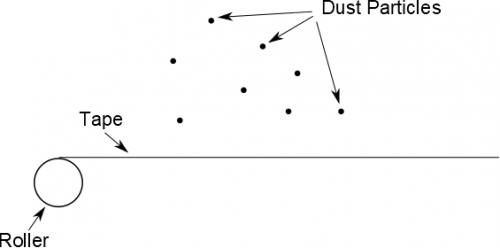This is an old revision of the document!
Project: StickyStuff and the Dust Particle
Adhesive tape is manufactured by repeatedly rolling and unrolling large sheets of plastic, which can cause there to be a charge on the surface of the tape. Why this important, you may ask? Trapped in the town of Lakeview, the S.P.A.R.T.A.N force has been called to the premises of StickyStuff Corporation. Local conspiracy theorist Manny Habañero has convinced the CEO of StickyStuff Corp that the crazy thunderstorms are related to strange creatures he's seen in the woods near town. He claims they are about the size of a mountain lion and have fur like a cat, and he thinks that if he leaves strips of special tape in the areas where they've been spotted, it will collect some of their hair and prove that they're real.
Unfortunately, there has recently been a dust problem in the StickyStuff manufacturing plant. Dust particles (on average, $q=0.802 \times 10^{-14}$ C, $m=5.5 \times 10^{-8}$ g) have been accumulating on the tape as it rolls through the assembly line. The problem has been isolated to a single roller, which operates for 10 seconds at a time at a power of 100 watts (where 1 watt = 1 J/s). Using your handy-dandy-super-extender tape measure, you find that exactly 30 m of tape passes over the roller during each 10 second time period. Your team needs to determine where to put a fan and how much force the fan needs to exert on each dust particle, such that the fan blows away any dust that may be attracted to the tape. The tape must be in excellent condition before being set out to collect fur samples. From your adhesive engineering education, you have access to a table that you think may help.
(There's actually a pretty cool “How it's Made” video here if you have time at the end.)
Learning Goals
- Create an analytic model for a line of charge
- Be able to explain how you set up each part of the integral, $dQ$, $r$, limits, etc.
- Explain how you used superposition in your solution
- Understand how surfaces become charged (particularly as an insulator in this case)
Conceptual Questions:
- What is charge affinity?
- What is dQ in the integral set up? Why do we rewrite dQ so it is in terms of dx?
- How do you rewrite your separation vector? What is r_source? What is r_obs?
- In the separation vector, should you have x as a variable or dx? Why?
- How did you pick your bounds for your integral?
- How do you integrate a vector? What steps would you follow?
- How did you use superposition today? Where is superposition represented in your equations?
